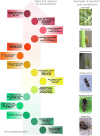Gene Editing and Genetic Control of Hemipteran Pests: Progress, Challenges and Perspectives
- PMID: 35747496
- PMCID: PMC9209771
- DOI: 10.3389/fbioe.2022.900785
Gene Editing and Genetic Control of Hemipteran Pests: Progress, Challenges and Perspectives
Abstract
The origin of the order Hemiptera can be traced to the late Permian Period more than 230 MYA, well before the origin of flowering plants 100 MY later in during the Cretaceous period. Hemipteran species consume their liquid diets using a sucking proboscis; for phytophagous hemipterans their mouthparts (stylets) are elegant structures that enable voracious feeding from plant xylem or phloem. This adaptation has resulted in some hemipteran species becoming globally significant pests of agriculture resulting in significant annual crop losses. Due to the reliance on chemical insecticides for the control of insect pests in agricultural settings, many hemipteran pests have evolved resistance to insecticides resulting in an urgent need to develop new, species-specific and environmentally friendly methods of pest control. The rapid advances in CRISPR/Cas9 technologies in model insects such as Drosophila melanogaster, Tribolium castaneum, Bombyx mori, and Aedes aegypti has spurred a new round of innovative genetic control strategies in the Diptera and Lepidoptera and an increased interest in assessing genetic control technologies for the Hemiptera. Genetic control approaches in the Hemiptera have, to date, been largely overlooked due to the problems of introducing genetic material into the germline of these insects. The high frequency of CRISPR-mediated mutagenesis in model insect species suggest that, if the delivery problem for Hemiptera could be solved, then gene editing in the Hemiptera might be quickly achieved. Significant advances in CRISPR/Cas9 editing have been realized in nine species of Hemiptera over the past 4 years. Here we review progress in the Hemiptera and discuss the challenges and opportunities for extending contemporary genetic control strategies into species in this agriculturally important insect orderr.
Keywords: CRISPR/Cas9; Hemiptera; gene editing; genetic control; mutations; whiteflies.
Copyright © 2022 Pacheco, Walling and Atkinson.
Conflict of interest statement
The authors declare that the research was conducted in the absence of any commercial or financial relationships that could be construed as a potential conflict of interest.
Figures





References
-
- Al-Wahaibi A. K., Morse J. G. (2009). Egg Stage of Homalodisca vitripennis and Homalodisca liturata (Hemiptera: Cicadellidae): Ovometrics, Embryonic Development, and Nonparasitic Mortality. Ann. Entomol. Soc. Am. 102, 249–260. 10.1603/008.102.0207 - DOI
Publication types
LinkOut - more resources
Full Text Sources
Miscellaneous

